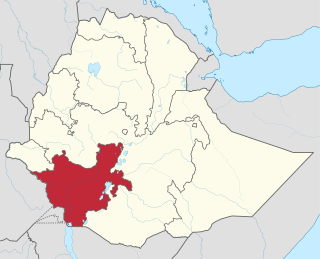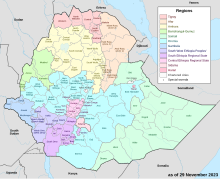
The Southern Nations, Nationalities, and Peoples' Region was a regional state in southwestern Ethiopia. It was formed from the merger of five kililoch, called Regions 7 to 11, following the regional council elections on 21 June 1992. Its government was based in Hawassa.

Gedeo is a zone in the South Ethiopia Regional State (SERS) of Ethiopia. This zone is named for the Gedeo people, whose homelands lie in this zone. Gedeo is an exclave of the SERS consisting of a narrow strip of land along the eastern escarpment of the Ethiopian Highlands. It is surrounded by the Oromia Region, which borders the Zone on the east, south and west; Gedeo shares its northern boundary with the Sidama Region. Dilla is the administrative center; other towns include Dilla, Wonago, Yirgachefe, Chelelekitu and Gedeb.

Gurage is a zone in the Central Ethiopia Regional State of Ethiopia. The region is home to the Gurage people. Gurage is bordered on the southeast by Hadiya and Yem Zone, on the northwest by Kebena Special Woreda, north and east by the Oromia Region, and on the southeast by Silt'e. Its highest point is Mount Gurage. Welkite is the administrative centre of the Region; Butajira is the largest city in this zone and the former administrative centre.

Hadiya is a zone in the Central Ethiopia Regional State of Ethiopia. This zone is named after the Hadiya of the Hadiya Kingdom, whose homeland covers part of the administrative division. Hadiya is bordered on the south by Kembata, on the southwest by the Dawro Zone, on the west by the Omo River which separates it from Oromia Region and the Yem Special Woreda, on the north by Gurage, on the northeast by Silte, and on the east by the Alaba Zone; the woredas of Mirab Badawacho and Misraq Badawacho form an exclave separated from the rest of the zone by Kembata. The administrative center of Hadiya is Hosaena.
Ezhana Wolene was one of the 77 woredas in the Southern Nations, Nationalities, and Peoples' Region of Ethiopia. This woreda was named after two of the sub-groups of the Sebat Bet Gurage, the Ezha and the Wolene-Worriro. Part of the Gurage Zone, Ezhana Wolene was bordered on the south by Gumer, on the west by Cheha, on the north by Goro, on the northeast by Kokir Gedebano Gutazer, and on the east by Meskanena Mareko. The major town in Ezhana Wolene was Agenda. It was divided for Ezha and Muhor Na Aklil woredas.

Soddo is one of the woredas in the Southern Nations, Nationalities, and Peoples' Region of Ethiopia. This woreda is named after the Soddo Gurage people. It is Part of the Gurage Zone of the Southern Nations, Nationalities, and People's Region. Soddo is bordered on the south by Meskane, and on the west, north and east by the Oromia Region. The administrative center of Soddo is Bue; other towns include Kela.
Meskanena Mareko was one of the 77 woredas in the Southern Nations, Nationalities, and Peoples' Region of Ethiopia. Part of the Gurage Zone, Meskanena Mareko was bordered on the south by Silte, on the southwest by Gumer, on the west by Ezhana Wolene, on the northwest by Kokir Gedebano Gutazer, on the north by Sodo, and on the east by the Oromia Region. Towns in Meskanena Mareko included Butajira and Inseno. Meskanena Mareko was divided for Mareko and Meskane woredas and Butajira town.
Silti (ስልጢ) is one of the woredas in the Central Ethiopia Regional State of Ethiopia. It is named after a subgroup of the Silt'e people, whose homeland includes this woreda. Formerly part of the Gurage Zone, after a referendum held between 18 and 26 April 2001, this woreda became part of the Silt'e Zone. This woreda is bordered on the south by Lanfro and Dalocha, on the southwest by Wulbareg, on the west by Alicho Werero, on the north by the Gurage Zone, and on the east by the Oromia Region. The administrative center of this woreda is Kibet; other towns in Silti include Alkaso, and Werabe. Southwestern part of this woreda was added to Wulbareg woreda.
Gumer is one of the woredas in the Southern Nations, Nationalities, and Peoples' Region of Ethiopia. This woreda is named after one of the sub-groups of the Sebat Bet Gurage, the Gumer. Part of the Gurage Zone, Gumer is bordered on the southeast by the Silt'e Zone, on the southwest by Geta, on the northwest by Cheha, and on the north by Ezha. Towns in Gumer include Arek'it and B'ole. Geta and Alicho Werero woredas were separated from Gumer.
Cheha is one of the woredas in the Southern Nations, Nationalities, and Peoples' Region of Ethiopia. This woreda is named after one of the sub-groups of the Sebat Bet Gurage, the Cheha. Part of the Gurage Zone, Cheha is bordered on the south by Enemorina Eaner, on the west by the Oromia Region, on the north by the Wabe River which separates it from Abeshge and Kebena, on the east by Ezha, and on the southeast by Gumer and Geta. The administrative center for Cheha is Endibir; other towns include Gubre.
Enemorina Eaner is one of the woredas in the Southern Nations, Nationalities, and Peoples' Region of Ethiopia. This woreda is named in part after one of the sub-groups of the Sebat Bet Gurage, the Enemor, who are first mentioned in a list of groups paying tribute to Emperor Yeshaq I, and other sub-group, Eaner. Part of the Gurage Zone, Enemorina Eaner is bordered on the south by the Hadiya Zone, on the southwest by Yem special woreda, on the west by Oromia Region, on the north by Cheha, on the east by Geta, and on the southeast by Endegagn. The administrative center of Enemorina Eaner is Gunchire. Endegagn was separated from this woreda.
Ejerie is a woreda in Oromia Region, Ethiopia. Part of the West Shewa Zone, it is bordered on the south by the Southwest Shewa Zone, on the west by Dendi, on the northwest by Jeldu, on the north by Meta Robi, on the northeast by Adda Berga, and on the east by Walmara. The major town in Ejerie is Ejerie town, after which the district has been named.
Waliso is one of the woredas in the Oromia Region of Ethiopia. It was part of former Walisona Goro Aanaa what was separated for Goro (Aanaa) and Waliso Aanaa and Waliso Town. Part of the Southwest Shewa Zone, it was bordered on the south by the Southern Nations, Nationalities and Peoples Region, on the west by Amaya, on the northwest by Wonchi, on the north by Dawo, on the northeast by Becho and on the east by Saden Soddo. Towns in Waliso include Waliso and Dilala.
Seden Sodo is one of the woredas in Oromia Region, Ethiopia. it is bordered on the Southern Nations, Nationalities and Peoples Region, Gedebeno Gutezer Wereda or Gurage zone on the west by weliso, by north by Bacho wereda on the northeast by Tole wereda, and on the east by Kersa Malima. The major town in Seden Sodo is Harbu Chulule.
Nannawa Adama is a woreda in Oromia Region, Ethiopia. Part of the East Shewa Zone located in the Great Rift Valley, Adama Zuria is bordered on the south by the Arsi Zone, on the southwest by Koka Reservoir which separates it from Dugda Bora, on the west by Lome, on the north by the Amhara Region, and on the east by Boset; the Awash River, the only important river in this woreda, defines the woreda boundaries on the east and south. Other towns in this woreda include Awash Melkasa, Shewa Alemtena, Sire Robi, Sodere and Wenji Gefersa.
Dugda is a district in the Oromia Region of Ethiopia. It was part of the former district of Dugda Bora before being divided into Bora and Dugda. Part of the East Shewa Zone located in the Great Rift Valley, Dugda is bordered on the southeast by Hora-Dambal, on the south by Adami Tullu and Jido Kombolcha, on the west by the Southern Nations, Nationalities and Peoples Region, on the northwest by the Southwest Shewa Zone, on the north by the Awash River which separates it from Ada'a Chukala, on the northeast by Koka Reservoir which separates it from Adama, and on the east by the Arsi Zone. The administrative center of Dugda is Meki.
Adami Tullu and Jido Kombolcha is one of the districts in the Oromia Region of Ethiopia. Part of the East Shewa Zone located in the Great Rift Valley, Adami Tullu and Jido Kombolcha is bordered on the south by West Arsi Zone with which it shares the shores of Lakes Abijatta and Langano, on the west by the Silte Zone of Southern Nations, Nationalities and Peoples Region, on the north by Dugda Bora, on the northeast by Hora-Dambal, and on the east by the Arsi Zone. The main town of district is Adami Tullu; other towns include Abosa, Bulbulla, and Jido.
Tiyo is a woreda in Oromia Region, Ethiopia. Part of the Arsi Zone, Tiyo is bordered on the south by Munesa, on the west by Batu Dugda, on the northeast by Hitosa, and on the southeast by Digeluna Tijo. The administrative center of the woreda and Zone is Asella; other towns in Tiyo include Gonde.
Adola is one of the woredas in the Oromia Region of Ethiopia. It is part of former Adolana Wadera woreda what was divided for Adola, Girja and Wadera woredas and Adola town. Part of the Guji Zone, Adolana Wadera was bordered on the south by Liben, on the southwest by Odo Shakiso, on the west by Bore, on the north by the Southern Nations, Nationalities, and Peoples Region, and on the east by the Bale Zone.
Meskan is one of the woredas in the Southern Nations, Nationalities, and Peoples' Region of Ethiopia. This woreda is named after the Meskan speaking Gurage people. Part of the Gurage Zone, Meskane is bordered on the south by the Silt'e Zone, on the west by Muhor Na Aklil, on the northwest by Kokir Gedebanoon the north by sodo wereda, on the northeast by Sodo and Oromia, and on the southeast by Mareko. Towns in Meskane include Inseno. The town of Butajira is the capital town of Meskane. Meskane was part of the former Meskanena Mareko woreda.



